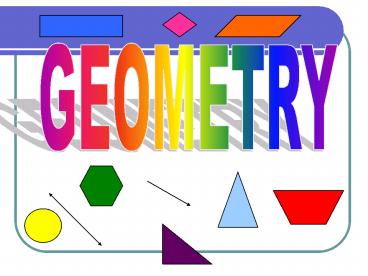Geometry PowerPoint PPT Presentation
1 / 24
Title: Geometry
1
GEOMETRY
2
Geometry
- Introduction
3
- Geometry is a branch of mathematics that deals
with points, lines, planes and solids, and
examines their properties, measurement, and
mutual relationship in space.
4
- Geometry was used by ancient Egypt to measure
land and build pyramids. The Greeks used a
straightedge and a compass to draw lines and
circles. They discovered ways to calculate
distances without actually measuring them.
5
- People in many fields use geometry. For example,
engineers, rocket scientists, surveyors,
designers, graphic artists, carpenters,
astronomers, plumbers, laboratory technologists,
advertising copywriters, construction workers,
chemists, astronauts, and many more.
6
- Geometry is used by anyone who needs to draw a
circle, line, or line segment. The name geometry
comes from two Greek words geo, meaning land,
and metry, meaning to measure.
7
Applications
8
- A Greek mathematician named Euclid brought
together most of the knowledge of geometry. He
set down general rules that he called axioms,
postulates, and theorems. He published a
13-volume work called The Elements. Euclids
system of geometry is called Euclidean Geometry.
Students study Euclidean Geometry in high school.
9
- Other mathematicians who contributed to the
formation of geometry are Pythagoras, Gauss,
Lewis Carroll, Johannes Kepler, and many others.
10
- Much of the reasoning in geometry consists of
three stages. - 1. Look for a pattern
- 2. Make a conjecture
- 3. verify the conjecture
11
1-2 Points, Lines, and Planes
- In geometry, some words, such as point, line, and
plane, are undefined terms. - A point has no dimension. It is usually
represented by a small dot. - A line extends in one dimension. It is
represented by a straight line with two
arrowheads to indicate that the line extends
without end in two directions. - Space is a boundless, three dimensional set of
all points.
12
- A plane extends in two dimensions. It is usually
represented by a shape that looks like a tabletop
or wall. - Collinear points are points that lie on the same
line. - Non-collinear points are points that do not lie
on the same line. - Coplanar points are points that lie on the same
plane.
13
- Noncoplanar points are points that do not lie on
the same plane. - A line segment or segment is a part on a line
that consists of two endpoints and all points
between those endpoints. - A ray is part of a line that consists of a point,
called an initial point, and all points on the
line that extend in one direction.
14
- Intersect-Two or more geometric figures intersect
if they have one or more points in common. - Intersection-The intersection of figures is the
set of points that the figures have in common.
15
A point has no dimension.
It is usually represented by a small dot.
16
A line extends in one dimension. It is usually
represented by a straight line with two
arrowheads to indicate that the line extends
without end in two directions.
Collinear points are points that lie on the same
line.
17
A plane extends in two dimensions. It is
usually represented by a shape that looks like
a table or a wall, however you must imagine that
the plane extends without end.
18
Coplanar points are points that lie on the same
plane.
Plane M or plane ABC
19
Name three points that are collinear.
Name four points that are coplanar.
Name three points that are not collinear.
SOLUTION
Points D, E, F lie on the same line, so they
are collinear.
Points D, E, F, and G lie on the same plane, so
they are coplanar.
Also, D, E, F, and H are coplanar.
There are many correct answers. For instance,
points H, E, and G do not lie on the same line.
20
(No Transcript)
21
Draw three noncollinear points J, K, L. Then
draw JK, KL and L J.
SOLUTION
Draw J, K, and L
22
Draw two lines. Label points on the lines and
name two pairs of opposite rays.
SOLUTION
Points M, N, and X are collinear and X is
between M and N.
Points P, Q, and X are collinear and X is
between P and Q.
23
SKETCHING INTERSECTIONS OF LINES AND PLANES
Two or more geometric figures intersect if they
have one or more points in common. The
intersection of the figures is the set of
points the figures have in common.
24
Sketch two planes that intersect in a line.
SOLUTION
Draw two planes.
Emphasize the line where they meet.
Dashes indicate where one plane is hidden by the
other plane

